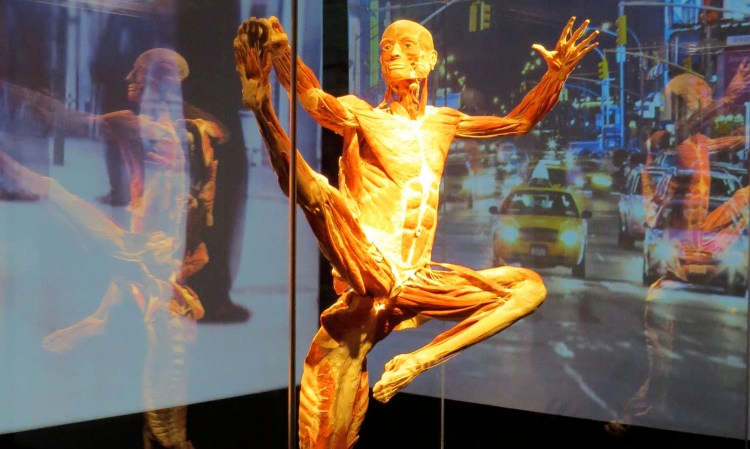The Portland Science Center’s debut has been delayed for nearly two months by the need for more fireproofing. But when the museum does open on the waterfront in late August, it will present a world-renowned and sometimes controversial exhibit that features preserved human bodies and organs.
“Body Worlds” is an example of the nationally known exhibits that the science center’s managers hope to host each year. And with nothing else like it in the area, the center could be a major family entertainment draw among the shops, wharves and eateries on the waterfront.
“I think it’s huge. I think (the science center) is going to be a tremendous asset and fit in perfectly to the waterfront,” said Casey Gilbert, executive director of Portland’s Downtown District. “I know that many families are looking for things to do with kids downtown.”
Emeline Emery, a physician assistant from Augusta who saw “Body Worlds” in Boston, called the chance to see the exhibit in Maine “a once-in-a-lifetime opportunity” for anyone interested in the body’s inner workings.
Emery found it interesting to be able to see different bodies stripped down to reveal individual systems. But she cautioned that people should consider that they will be seeing real bodies.
“I thought it was great to be able to see actual bodies, not just pictures,” Emery said.
“Body Worlds” was developed by German anatomist Gunther von Hagens more than 20 years ago. The exhibit uses a technique called plastination to reveal the insides of preserved bodies. The exhibits have toured the world, drawing more than 40 million people and some protests over the display of actual human remains.
In 2012, for example, a group led by Ohio State faculty protested a “Body Worlds” exhibit in Columbus. To counter some of the controversy, the “Body Worlds” website includes a pledge that all bodies used were willingly donated, as well as an “ethical review” of the exhibit organized by the California Science Center.
The bodies are donated directly for the purpose of the exhibit, and the donors consent to have their bodies put on display, according to the “Body Worlds” website. Von Hagens invented the plastination procedure for preserving bodies for study in 1977.
“Body Worlds” mostly has been exhibited in large cities, including London, Brussels and Berlin. In the United States, host cities have included Los Angeles, Dallas and Charlotte, North Carolina.
The Portland Science Center is located at 68 Commercial St., on Maine Wharf, one wharf west of the Maine State Pier. It’s run by The Gold Group, a Massachusetts-based company that promotes and produces educational exhibits. Exhibits promoted by the group in other cities include “Dead Sea Scrolls,” “Sea Monsters Revealed” and “Pompeii.” The center likely will host two such exhibitions a year in Portland.
The Gold Group had announced in early June that the science center would open by early July. Organizers did not say then what the first exhibit might be.
The center’s opening has been delayed because of work on additional fireproofing required to use the space as a museum instead of for offices. That work has included spraying fire-resistant material on the walls of the 12,000-square-foot space, as well as other safety improvements, said Jeff Levine, the city’s planning director.
“With a space like this, you have more people in it who are not familiar with the space, so the (fire safety) requirements are different,” Levine said.

A visitor looks at plastinated human bodies during a February 2015 media preview before the opening of the “Body Worlds” exhibit in Berlin. Plastination preserves real human remains for study using a process that replaces bodily fluids and fat with fluid plastic.
The science center got its building permit approved July 24. Joe Gold of The Gold Group said Monday that much of the fire safety work has been done. The rest of the month will be devoted to completing construction and installing the “Body Worlds” exhibit, he said.
Gold said “Body Worlds” will be on view at the science center through 2015, with other yet-to-be announced exhibits to follow. Tickets will likely be no more than $20 for adults and $15 for children, he said. Most exhibits at the center will have 125 to 250 objects or specimens, plus interactive components.
The science center will have an entrance on the first floor and take up the top two floors of a three-story building that was renovated in the past two years. The building looks like several connected buildings and is painted a variety of colors, including green, blue and red.
The building permit application estimated the cost of the work at $225,000. Gold said the cost to renovate the space and bring in “Body Worlds” will be over $1 million, spent by his company and building owner Stephen Goodrich.
In addition to the science center, the building will house an art gallery and a restaurant run by Portland restaurateurs Dana Street and Sam Hayward. The two also run the upscale restaurant Fore Street.
Send questions/comments to the editors.




Comments are no longer available on this story